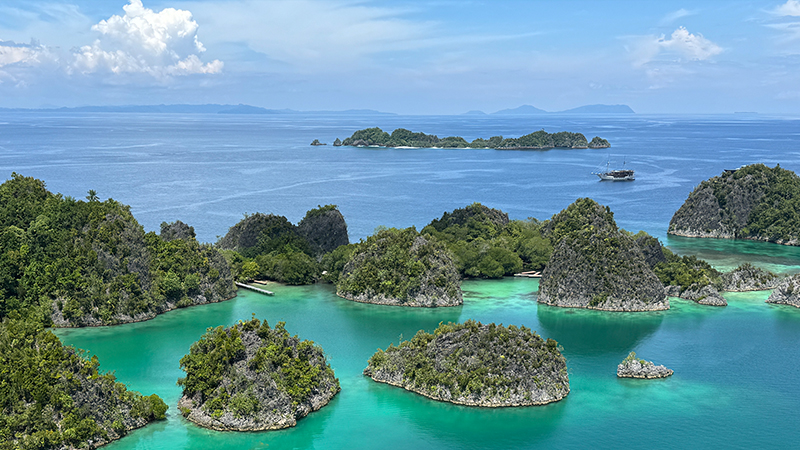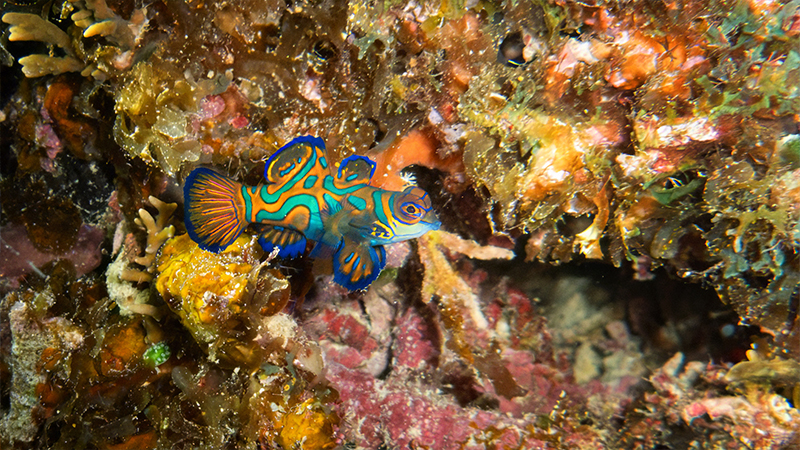Expat Living contributor LINDSAY SHERMAN discovers extraordinary scuba diving in Raja Ampat, an archipelago in the far eastern part of Indonesia whose waters teem with marine life.
Whenever I head to a new location, there are a few species that I secretly hope to see. Heading off for a week of scuba diving in Raja Ampat, I had similar high hopes. I just didn’t expect to tick off my entire bucket list by day two!

Kri Island and the Coral Triangle
For our diving holiday in Raja Ampat, we would be staying on Kri Island, in a resort run by Papua Diving Resorts. This part of Indonesia lies at the centre of the Coral Triangle, an area of the Indo-Pacific that is home to 75% of the world’s coral species and 37% of the world’s reef fish. It has a big reputation in scuba circles, one that it more than lives up to.
Getting to Raja Ampat is not easy, however. Flights arrive at the nearest airport at Sorong in the early morning, which means a red-eye domestic flight from either Bali or Jakarta. We then took a 90-minute boat transfer to the resort. Kri is one of the many limestone islands in the Raja Ampat archipelago. Fringed by white beaches and turquoise reefs and topped with emerald green jungle, we were mesmerised before we stepped off the boat.
Constructed using local materials, the resort’s well-equipped, spacious rooms peek out of the greenery, overlooking the house reef. But we weren’t there for the accommodation. Beckoning us were the 48 dive sites accessible from the resort. We wasted no time and were in the water within hours of arriving.
The resort offers packages of seven, 10 or 14 days. We soon realised that seven days was just not enough. In addition to the dive sites, there are excursions to see Birds of Paradise as well as scenic outings to insta-famous island groups and more.
Ticking off my wildlife wish list
Among those are the Fam Islands, best known for the panoramic lookout from the Piaynemo viewpoint. They also house one of the best dive sites in Raja Ampat – Melissa’s Garden. Here, vibrant soft corals gently sway in the swell and hard corals frame jewel-coloured fish. Peering under a hard coral shelf, I found a juvenile pinnate batfish. Black with a fluorescent orange outline, this little beauty was on my target list.
The mantis shrimp was another species I long wished to see. I found it on Cape Kri, a dive site adjacent to the resort. This is where Australian Dr Gerald Allen broke a world record by encountering 374 different species in one dive!
Cape Kri was also the location of another special sighting. The snorkeller in our group saw an epaulette or walking shark. Showcased in David Attenborough’s Great Barrier Reef documentary, the walking shark is considered such a rare sighting that it was not even on my wish list. Snorkellers are well looked after on outings, and they can end up seeing as much as divers. Dugong was another species our snorkeller saw that the scuba divers missed.

Mandarinfish and Manta rays
For me, the most exciting encounter was several male and female mandarinfish. They live in the structure of the reef and patient scuba divers can glimpse them as they emerge to feed at dusk.
Manta rays, meanwhile, are always high on any diver’s target list. We booked our spot at their cleaning station, known as Manta Sandy. Luckily, we encountered mantas stopping off for a quick grooming session courtesy of schools of friendly cleaner wrasse (which feed off tissues and parasites on larger marine life).
Bookings at Manta Sandy are managed by the local islanders to minimise diver numbers swelled by the many liveaboards touring the area. It’s part of the greater marine park conservation system established 20 years ago to protect Raja Ampat’s reefs.

Final word on Raja Ampat
Having raced through my fish bucket list, you might think that my scuba ambitions are complete. On the contrary, seven days in Raja Ampat has only fuelled a desire to return. We have already booked another trip – 14 days will probably not seem enough!

Want more travel ideas for your next trip from Australia? Take a look at these African safaris!




